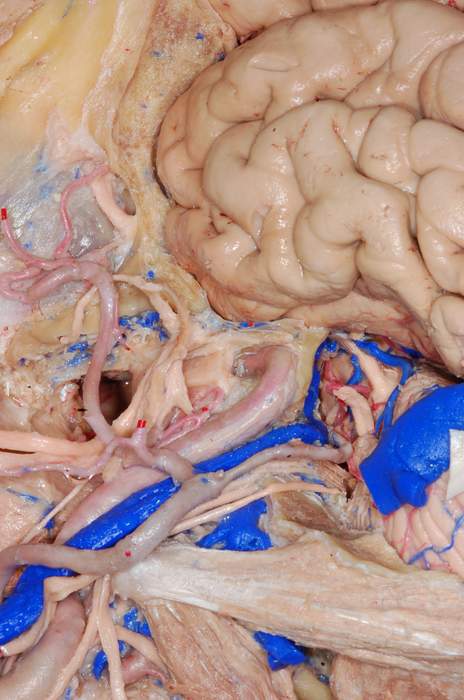Left Lateral Oblique View of Temporal Lobe, Infratemporal Fossa, and Deep Neck Structures
7435

Surgical Correlation
Tags
Left lateral oblique view of temporal lobe, infratemporal fossa, and deep neck structures. The mandibular ramus, zygomatic arch, and portion of lateral skull and meninges have been removed. The lateral surface of the temporal lobe is in view with the superior, middle, and inferior temporal gyri separated by the superior and middle temporal sulci. The lateral sulcus separates the temporal lobe from the frontal and parietal lobes. The tentorium cerebelli (unlabeled) separates the brainstem and cerebellum from the occipital lobes of the cerebrum. In the infratemporal fossa the lateral pterygoid and medial pterygoid muscles have been removed. The tensor veli palatini and part of the superior pharyngeal constrictor have also been removed to expose the interior of the pharynx. Posterior to the ramus of the mandible is the external carotid artery and its terminal branches, the superficial temporal and the maxillary arteries. The maxillary artery crosses the center of the image where it normally courses superficial to the lateral pterygoid muscle. Branches in view here are the inferior alveolar, the middle meningeal, anterior deep temporal, posterior superior alveolar arteries, the infraorbital, and the sphenopalatine artery entering the pterygopalatine fossa through the pterygomaxillary fissure. The maxillary nerve can be seen emerging from the foiramen rotundum and traversing the upper portion of the pterygopalatine fossa. The mandibular nerve emerges from the foramen ovale into the infratemporal fossa before dividing into branches. The auriculotemporal and buccal nerves lie posterior to the lateral pterygoid while the inferior alveolar and lingual nerves emerge between this muscle and the medial pterygoid to course toward the mandibular canal and floor of the mouth, respectively. The inferior alveolar nerve and artery gives rise to mylohyoid branches that supply the mylohyoid and anterior digastric muscles. Deep to the mandibular ramus are the internal carotid artery and internal jugular vein. The cervical segment of the artery continues as the petrous segment as it passes into and through the carotid canal. The internal jugular vein emerges from the nearby jugular foramen. Deep neck musculature has been removed to expose the suboccipital triangle muscles consisting of the obliquus capitis inferior and superior muscles and the rectus capitis posterior major muscle. Part of the vertebral artery is exposed prior to entering the transverse foramen of the atlas. It is crossed superficially by the ventral ramus of the C2 spinal nerve. The hypoglossal nerve emerges between the IJV and proximal part of the ECA and courses forward superficial to the hyoglossus muscle to the oral cavity and tongue musculature. The superior root of the ansa cervicalis (containing C1 nerve fibers) leaves the epineurial sheath of the hypoglossal and descends in the neck where it unites with the inferior root to supply motor innervation to most of the infrahyoid muscles. The carotid sinus nerve, a sensory branch of the glossopharyngeal nerve, innervates the baroreceptors of the carotid sinus and the chemoreceptors of the carotid body. (Image courtesy of PA Rubino)



